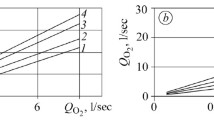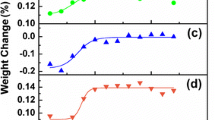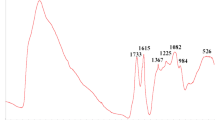Abstract
The oxidation, in a neat oxygen atmosphere, of high-purity and highly crystalline natural graphite and synthetic Kish graphite was investigated. The physico-geometric model function of the kinetic rate equation was experimentally determined by isothermal thermogravimetric analysis at 650 °C. Analytic solutions for basic flake shapes indicate that this function strictly decreases with conversion. However, for both samples the experimental data trend was a rapid initial increase followed by the expected decrease to zero. High resolution field emission scanning electron microscopy, of partially oxidized flakes, provided plausible explanations for this discrepancy. Rapid development of macroscopic surface roughness during the initial stages of oxidation was evident and could be attributed to the presence of catalytic impurities. Large fissures along the planes of the natural graphite and the initiation, growth and coalescence of internal cavities in the Kish graphite were observed. Flake models incorporating the latter two features are difficult to analyse analytically. However, a facile probabilistic approach showed that reasonably good agreement with experimental data was possible.













Similar content being viewed by others
References
De Torre LEC, Llanos JL, Bottani EJ. Graphite oxidation in air at different temperatures. Carbon. 1991;29:1051–61.
Fuller EL, Okoh JM. Kinetics and mechanisms of reaction of air with nuclear grade graphites: IG-110. J Nucl Mater. 1997;240:241–50.
Šesták J, Berggren G. Study of the kinetics of the mechanism of solid-state reactions at increasing temperatures. Thermochim Acta. 1971;3:1–12.
Koga N. Physico-geometric kinetics of solid-state reactions by thermal analyses. J Therm Anal. 1997;49:45–56.
Hurt RH, Haynes BS. On the origin of power-law kinetics in carbon oxidation. Proc Combust Inst. 2005;30:2161–8.
Feng B, Bhatia SK. On the validity of thermogravimetric determination of carbon gasification kinetics. Chem Eng Sci. 2002;57:2907–20.
Koga N, Tanaka H. A physico-geometric approach to the kinetics of solid-state reactions as exemplified by the thermal dehydration and decomposition of inorganic solids. Thermochim Acta. 2002;388:41–61.
Gimzewski E. The relationship between oxidation induction temperatures and times for petroleum products. Thermochim Acta. 1992;198:133–40.
Zaghib K, Song X, Kinoshita K. Thermal analysis of the oxidation of natural graphite: isothermal kinetic studies. Thermochim Acta. 2001;371:57–64.
Kim ES, Lee KW, No HC. Analysis of geometrical effects on graphite oxidation through measurement of internal surface area. J Nucl Mater. 2006;348:174–80.
Gulbransen EA, Andrew KF, Brassart FA. The oxidation of graphite at temperatures of 600° to 1500 °C and at pressures of 2 to 76 Torr of Oxygen. J Electrochem Soc. 1963;110:476–83.
Gulbransen EA, Andrew KF. Reactions of artificial graphite: kinetics of oxidation of artificial graphite at temperatures of 425° to 575 °C and pressures of 0.15 to 9.8 cm of mercury of oxygen. Ind Eng Chem. 1952;44:1034–8.
Xiaowei L, Jean-Charles R, Suyuan Y. Effect of temperature on graphite oxidation behaviour. Nucl Eng Des. 2004;227:273–80.
Laine NR, Vastola FJ, Walker PL Jr. Importance of active surface area in the carbon-oxygen reaction. J Phys Chem. 1963;67:2030–4.
Walker PL Jr, Taylor RL, Ranish JM. An update on the carbon-oxygen reaction. Carbon. 1991;29:411–21.
Badenhorst H, Rand B, Focke WW. Modelling of natural graphite oxidation using thermal analysis techniques. J Therm Anal Calorim. 2010;99:211–28.
Ranish JM, Walker PL Jr. Models for roughening of graphite during its catalyzed gasification. Carbon. 1990;28:887–96.
Hennig GR. Catalytic oxidation of graphite. J Inorg Nucl Chem. 1962;24:1129–37.
McKee DW, Chatterji D. The catalytic behaviour of alkali metal carbonates and oxides in graphite oxidation reactions. Carbon. 1975;13:381–90.
Acknowledgements
This work is based upon research supported by the Skye Foundation, PBMR and the South African Research Chairs Initiative of the Department of Science and Technology and the National Research Foundation. Any opinion, findings and conclusions or recommendations expressed in this material are those of the authors and therefore the PBMR, NRF and DST do not accept any liability with regard thereto.
Author information
Authors and Affiliations
Corresponding author
Rights and permissions
About this article
Cite this article
Badenhorst, H., Focke, W.W. Geometric effects control isothermal oxidation of graphite flakes. J Therm Anal Calorim 108, 1141–1150 (2012). https://doi.org/10.1007/s10973-012-2302-x
Received:
Accepted:
Published:
Issue Date:
DOI: https://doi.org/10.1007/s10973-012-2302-x




